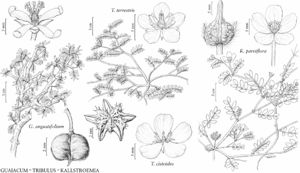Difference between revisions of "Tribulus cistoides"
Sp. Pl. 1: 387. 1753.
FNA>Volume Importer |
imported>Volume Importer |
||
| (One intermediate revision by the same user not shown) | |||
| Line 34: | Line 34: | ||
|elevation=0–10 m. | |elevation=0–10 m. | ||
|distribution=Fla.;Ga.;La.;s Africa;introduced also in Mexico;West Indies;n South America;Pacific Islands. | |distribution=Fla.;Ga.;La.;s Africa;introduced also in Mexico;West Indies;n South America;Pacific Islands. | ||
| + | |introduced=true | ||
|discussion=<p><i>Tribulus cistoides</i>, native to tropical and subtropical southern Africa, is occasionally grown in sandy soils as a garden ornamental or along roads to stabilize shifting soils (D. M. Porter 1972). Although <i>T. cistoides</i> has been reported from Texas, no specimen has been seen and it apparently does not occur there. The species has been introduced to the Galápagos Islands, but not to mainland Ecuador.</p> | |discussion=<p><i>Tribulus cistoides</i>, native to tropical and subtropical southern Africa, is occasionally grown in sandy soils as a garden ornamental or along roads to stabilize shifting soils (D. M. Porter 1972). Although <i>T. cistoides</i> has been reported from Texas, no specimen has been seen and it apparently does not occur there. The species has been introduced to the Galápagos Islands, but not to mainland Ecuador.</p> | ||
|tables= | |tables= | ||
| Line 58: | Line 59: | ||
|publication year=1753 | |publication year=1753 | ||
|special status=Weedy;Introduced;Illustrated | |special status=Weedy;Introduced;Illustrated | ||
| − | |source xml=https:// | + | |source xml=https://bitbucket.org/aafc-mbb/fna-data-curation/src/2e0870ddd59836b60bcf96646a41e87ea5a5943a/coarse_grained_fna_xml/V12/V12_780.xml |
|genus=Tribulus | |genus=Tribulus | ||
|species=Tribulus cistoides | |species=Tribulus cistoides | ||
Latest revision as of 19:17, 5 November 2020
Herbs, perennial; herbage hairy (often silvery gray), becoming glabrate. Stems prostrate to suberect, green to reddish, to 0.8 m, densely sericeous, ± hirsute, especially at nodes. Leaves 2.5–8.5 × 1–2.6 cm; stipules 3–9 × 1–4 mm; leaflets 12–16(–20), obliquely oblong to elliptic, largest 6–21 × 2.5–9 mm, densely sericeous when young, whitish abaxially. Pedicels longer than shorter pair of leaves, in flower (6–)19–35 mm, in fruit 11–34 mm, apex bent. Flowers 15–25 mm diam.; sepals lanceolate, 5–9 × 1.5–3.5 mm, ciliate, densely strigose, silky-pubescent; petals obovate-cuneate, (5.5–)7–17 × (3–)5–11 mm; outer whorl of nectary glands green, inner whorl basally connate into 5-lobed urceolate ring surrounding base of ovary, yellow, broadly triangular, to 1 mm; stamen filaments 2.5–5 mm; anthers yellow, oblong-cordate to narrowly sagittate, 1–3 mm; ovary 1.5–3 mm diam.; style 5-ridged, cylindric, stout, 1–2 mm; stigma globose to pyramidal. Schizocarps 8–10 mm diam. excluding 7 mm spines; mericarps bearing 2 conic spreading 5–7 mm dorsal spines and sometimes 2 smaller retrorse spines near base [rarely spines absent and mericarps tuberculate, or spine 1], body green to gray, hispid, densely sericeous to strigose or glabrate.
Phenology: Flowering year-round.
Habitat: Dry disturbed habitats, especially in maritime areas.
Elevation: 0–10 m.
Distribution

Introduced; Fla., Ga., La., s Africa, introduced also in Mexico, West Indies, n South America, Pacific Islands.
Discussion
Tribulus cistoides, native to tropical and subtropical southern Africa, is occasionally grown in sandy soils as a garden ornamental or along roads to stabilize shifting soils (D. M. Porter 1972). Although T. cistoides has been reported from Texas, no specimen has been seen and it apparently does not occur there. The species has been introduced to the Galápagos Islands, but not to mainland Ecuador.
Selected References
None.
